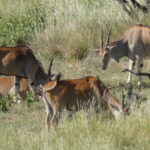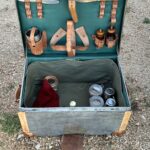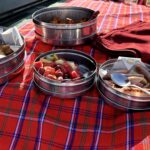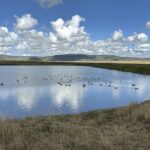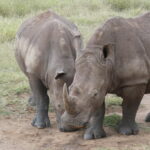purchase Lurasidone online Monday Morning Game Drive
http://debashishbanerji.com/reviews/arvind-akkis-world-of-liquid-fire/ The moon was still bright when we left at 6:30 AM for our third game drive here at Lewa Conservancy. the previous evening, we arranged with Abdul to carry breakfast out and stop during our drive to enjoy it.
Again we saw many of the same species of animals we had encountered previously. Early in the morning, the natural light isn’t the best for photos.
Abdul told us stories about big game hunting, poachers, and how times have changed. He asked us what happened to poachers when they got caught. After a few guesses, he laughed and said: we turn them into park rangers. Here at the conservancy, they count the rhinos every morning. They employ about 60 unarmed park rangers and 40 armed rangers. The armed rangers are trained by the US, Canadian, and British military. Originally, folks in town were resistant to government interference in most aspects of poaching but, after learning about poachers with huge numbers of kills, after realizing how they would eventually decimate herds of rhinos and elephants, and after realizing that their tourist industry would die, they began supporting efforts to conserve the wildlife.
Abdul drove us on some familiar roads, if you can call them roads. The are so bumpy that my watch reads them as exercise! My watch even says at the end of the day that I have taken over 18,000 steps – all the while sitting in the Land Cruiser!
We came across an Eland, one of the spiral horned antelopes. The Eland is the largest antelope and can weigh up to a ton. It is sort of cow-like, light tan in color, with faint white vertical stripes, and small horns. It moves about in groups. The eland was revered by the hunter-gatherers that once inhabited East Africa and they depicted it often on rock paintings they left behind. Eland meat is similar to venison and is hunted (off parks and conservancies) for its meat.
Jackson’s Hartebeest is one of Kenya’s more conspicuous large antelopes inhabiting its grasslands. It has large shoulders, a backward sloping back,slender torso, pale yellow-brown coat, smallish horns, and a narrow heart-shaped face. They often climb on termite hills to scan the area. They are usually found in northern Kenya. Often Coke’s Hartebeest will be found in the southern area and is called the kongoni,

Abdul bringing out the Kenya Coffee
Abdul navigated our Land Cruiser up onto a ridge overlooking the floor of the valley. Here we had our carry out breakfast served on the hood of our Land Cruiser. Abdul spread out one of our blankets on the hood of the truck, unpacked a trunk of goodies. We had yogurt with granola, fresh fruit, muffins, sausage and bacon, roasted vegetable medley, and of course, Kenyan coffee made with a French press!
Afterwards, we headed back to the lodge, stopping at the watering hole to see all the birds and two Hippos in the watering hole with only their eyes visible.
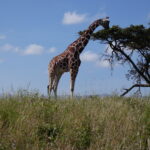
Giraffe using its long tongue to get the tender Acacia leaves
Also on the way, we saw a giraffe eating the soft tender leaves on the top of an acacia tree. Giraffes are able to get to the tender leaves without getting punctured by the large thorns on the tree because of their very long tongues. We learned that their horns are not attached to their skulls at birth. Males horns are usually attached by 3 years old; females by 7. Giraffes also have very powerful hearts to circulate their blood all the way up to their head – it is a very long neck! When giraffes are young the skin is tight on their skinny legs – acting like compression socks! As they age, that skin gets looser and they become prone to edema. Some even perish due to hypertension.
We came across an African buffalo with a very long horns.
We also saw a Warthog (no photo too quick)! It is Kenya’s wild pig, long legged and slender bodied. It has an almost hairless coat, a long dorsal mane, upward curving tusks, and callus-like warts on its face. They often trot away with their long thin tails held stiffly erect.
We had lunch at the lodge and took some time off before heading out again for our evening game ride. The weather was threatening rain and we went to a part of the conservancy where the animals are less plentiful.
We came across Black Rhinos. Most of the Rhinos we had seen up to now were White Rhinos (they aren’t white but their name comes from Dutch meaning “wide.”) The black rhinos are more aggressive than the white rhinos and more territorial. With its armored grey hide, massive bulk, fearsome horns, and irascible disposition, the Black Rhino is one of the most ancient branches of the species to survive. Adult male black rhinos are fairly solitary. Both sexes are aggressive with unfamiliar individuals but are accepting of rhinos with neighboring or overlapping territories, even pairing off temporarily. Their gestation period is about 15 months and a single calf can weigh 110 pounds and is usually mobile in 3 days. The mother and calf have a generally strong bond and will stay together about 3 to 4 years. The female will terminate her relationship with the calf once another calf is imminent. We stayed a bit away from them in case they decided that our land cruiser was a threat.
We saw gazelles, waterbuck, elephants, and birds. It got overcast and a bit chilly so we headed back to the lodge. We even found a road less traveled to take us there.


